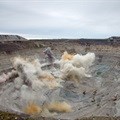
©Radisa Zivkovic via
123RFHaving made some exceptionally high readings of radioactivity in communities near mine tailings/slimes waste in the areas researched, the study notes that children swim freely in unfenced evaporation ponds below talings dams, radioactive water seeps into houses built in the floodplains of rivers, and houses built in the 500m exclusion zones of mine dumps are exposed to the radioactive mine dust blowing off the dumps.
In addition, researchers found high concentrations of children with physical and mental deformities in some of these areas, and point to a 2009 study linking high levels of uranium with birth abnormalities.
The Bench Marks Foundation study suggests that the gold mining industry, and both present and past governments, have a complete disregard for the dangers of mine waste facilities to residents of Soweto and other mine-impacted areas. The research notes that there is a close association between uranium and gold mining in South Africa, the implications of which became apparent during the Second World War and the race to build the first atom bomb.
“In this context, South Africa became a major supplier of very cheap uranium. Uranium from South Africa had a competitive edge in that it was a by product of established gold mining production and required no new investment in the start-up of mines. An abundance of uranium was also already present in the mountains of yellow waste (tailings) all over the southern parts of Johannesburg.”
However, less well known, says Bench Marks, are the health impacts of radiation on communities near mines.
Radiation risks in Johannesburg in general, and Soweto, in particular, are found in:
• Unfenced and unsecured mine waste facilities, particularly slimes/tailings accessible to the unknowing public;
• Informal settlers residing on abandoned mine sites;
• Stripping of radioactive materials from abandoned mine sites and uranium processing plants which are sold to scrap metal dealers;
• Use of tailings sand as a building mix for concrete, cement, and plaster to build houses;
• Inhaling and ingestion of dust blown from slimes/tailings dams;
• Runoff of mine water from tailings dams, or seepage into groundwater;
• Absorption of radioactive substances from the soil by plants including fruit and vegetables which are then consumed as food and incorporated into the body;
• Infiltration of radon gas, a by-product of uranium, into living spaces.
Radon gas, the by-product of decomposing uranium, is the second largest cause of lung cancer after smoking.
Exceptionally high readings of radioactivity
The research includes two instances – one in Meadowlands in January 2017 and the other in Doornkop in November 2016 – in which exceptionally high readings of radioactivity were found in communities in close proximity to mine waste in these areas.
It also reports on the high occurrence of children in the Doornkop area with physical and mental challenges, and points to research in Punjab, India, in 2009 which found high levels of uranium toxicity of urine samples of children with birth abnormalities, including physical deformities and neurological and mental disorders.
2003 DWAF study
Bench Marks is critical of a study done by the Department of Water Affairs and Forestry in 2003 on levels of radioactivity in the water in the Klip River catchment which found that “two of the sites showed marginal radioactivity status for infants… At both sites, care should be taken that the water is not used by infants under one year of age”.
However, says Bench Marks, the water referred to would be harmful to an unborn foetus, should pregnant mothers consume it: “The health effects of radiation on the foetus can be severe, even at radiation doses too low to make the mother sick.”
The shortcomings in the DWAF study, says Bench Marks, include that it:
• did not measure the water in the tailings evaporation ponds;
• did not measure the water at spill points where tailings water flows directly into the Booysens Spruit, the Russel stream or the Klipspruit;
• did not note that children from near tailings communities swim in this water;
• does not mention that there are some communities who, prior to being linked to the Rand Water grid, possibly consumed water directly from tailings facilities along the edge of Soweto;
• failed to look at seepage into RDP houses built in stream flood plains, or the artificial wetlands that result from tailings ground water plumes; and
• confused the Russel stream with Booysens Spruit. Russel stream goes nowhere near New Canada Road.


































